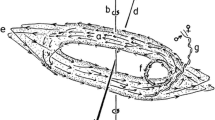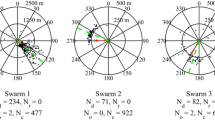Abstract
In the dance fly species Empis borealis (L.), females (1–40) gather to swarm at landmarks (swarm markers, like trees and bushes), and males carrying an insect prey visit these swarms for mating. We noticed earlier that some swarm sites were used for several years and that they appeared to be frequented by a similar number of swarming females in each year, although the numbers of females varied greatly among swarm sites and certain sites attracted more swarming individuals than others. To explore swarm site fidelity in this mating system, in 1993 we monitored the same swarm sites that we studied in 1989, addressing the questions, Would the same swarm sites still attract the same number of females and males after 4 years? and Why do some swarm sites attract more displaying females than others? The number of females swarming at the different markers in 1993 was approximately the same as 4 years earlier. Some of these swarm sites are known to have been used for 18 years. The swarm sites with the largest number of flies had a high sun exposure during the day and were found at coniferous swarm marker trees and in a mixed forest habitat. A swarm site with few females attending and with a low amount of insolation during the day can be predicted to be abandoned as a swarming site soon. Empis borealis swarm sites thus persist over many years and are attended by a similar number of individuals each year. To our knowledge, such site fidelity has not been demonstrated for any swarming insect species earlier.
Similar content being viewed by others
REFERENCES
Alcock, J. (1983a). Consistency in the relative attractiveness of a set of landmark territorial sites to two generations of male tarantula hawk wasps (Hymemoptera: Pompilidae). Anim. Behav. 31: 74-80.
Alcock, J. (1983b). Differences in site fidelity among territorial males of the carpenter bee Xylocopa varipunctata (Hymenoptera: Anthophoridae). Behaviour 125: 199-217.
Alcock, J. (1987). Leks and hilltopping in insects. J. Nat. Hist. 21: 319-328.
Bayfield, N. G. (1994). Effects of prey abundance on swarming Empis borealis L. (Diptera: Empididae) in north-east Scotland. Entomol. Gazette 45: 59-67.
Bradbury, J. W. (1985). Contrasts between insects and vertebrates in the evolution of male display, female choice and lek mating. Fortschr. Zool. 31: 273-289.
Crane, A. E. (1961). A study of the habits of Rhamphomyia scutellaris Coquillett (Diptera: Empididae). Wasman J. Biol. 19: 247-263.
Darwin, C. (1886). Über die Wege der Hummelmännchen. In Krause, E. (ed.), Gesammelte Schriften von Chales Darwin, Vol. 2, Leipzig, pp. 84-88.
Dodson, G. (1986). Lek mating system and large male aggressive advantage in a gall-forming tephritid fly (Diptera: Tephritidae). Ethology 72: 99-108.
Downes, J. A. (1969). The swarming and mating flight of Diptera. Annu. Rev. Entomol. 14: 271-298.
Evans, H. E. (1988). Observations on swarms of Rhamphomyia sociabilis (Williston) (Diptera: Empididae). J. N. Y. Entomol. Soc. 96: 316-322.
Freeman, R. B. (1968). Charles Darwin on the routes of male bumble bees. Bull Br. Mus. (Nat. Hist.) Hist. Ser. 3: 179-189.
Harker, J. E. (1992). Swarm behavior and mate competition in mayflies (Ephermeroptera). J. Zool. Lond. 228: 571-587.
Knapton, R. W. (1985). Lek structure and territoriality in the chryxus arctic butterfly, Oeneis chryxus (Saturidae). Behav. Ecol. Sociobiol. 17: 389-395.
Lindeberg, B. (1964).The swarm of males as a unit for taxonomic recognition in the chironomids. Ann. Zool. Fennica 1: 72-76.
Neems, R. M., Lazarus, J., and Mclachlan, A. J. (1992). Swarming behavior in male chironomid midges: A cost-benefit analysis. Behav. Ecol. 3: 285-290.
Nilssen, A. C., and Anderson, J. R. (1995). The mating sites of the reindeer nose bot fly: Not a practical target for control. Rangifer 15: 55-61.
Parker, G.A. (1978). Evolution of competitive mate searching. Annu. Rev. Entomol. 23: 173-196.
Preston-Mafham, K. G. (1999). Courtship and mating in Empis (Xanthempis) trigramma Meig., E. tesselata F. and E. (Polyblepharis) opaca F. (Diptera:Empididae) and the possible implications of 'cheating' behaviour. J. Zool. Lond. 247: 239-246.
SAS Institute (1987). SAS/STAT Guide for Personal Computers, SAS Institute, Cary, NC.
Savolainen, E. (1978). Swarming in Ephemeroptera: The mechanism of swarming and the effects of illumination and weather. Ann. Zool. Fennica 15: 17-52.
Shelly, T. E., and Whittier, T. S. (1995). Lek distribution in the Mediterranean fruit fly (Diptera: Tephritidae): Influence of tree size, foliage density, and neighborhood. Proc. Hawaiian Entomol. Soc. 32: 113-121.
Shelly, T. E., and Whittier, T. S. (1997). Lek behavior of insects. In Choe, J. C., and Crespi, B. (eds.), Social Competition and Cooperation in Insects and Arachnids, Vol 1. Evolution of Mating Systems, Cambridge University Press, Cambridge, pp. 273-293.
Sivinski, J. (1989). Lekking and small-scale distribution of the sexes in the Caribbean fruit fly, Anastrepha suspensa (Loew). J. Insect Behav. 2: 3-13.
Sivinski, J., and Petersson, E. (1997). Mate choice and species isolation in swarming insects. In Choe, J. C., and Crespi, B. (eds.), Social Competition and Cooperation in Insects and Arachnids, Vol 1. Evolution of Mating Systems, Cambridge University Press, Cambridge, pp. 294-309.
Sullivan, R. T. (1981). Insect swarming and mating. Fla. Entomol. 64: 44-65.
Svensson, B. G. (1979). Patrolling behaviour of bumble bee males (Hymenoptera, Apidae) in a subalpine/alpine area, Swedish Lapland. Zoon 7: 67-94.
Svensson, B. G. (1997). Swarming behavior, sexual dimorphism and female reproductive status in the sex-role reversed dance fly species Rhamphomyia marginata. J. Insect Behav. 10: 783-804.
Svensson, B. G., and Petersson, E. (1987). Sex-role reversed courtship behavior, sexual dimorphism and nuptial gifts in the dance fly Empis borealis (L.). Ann. Zool. Fennici 24: 323-334.
Svensson, B. G., and Petersson, E. (1988). Non-random mating in the dance fly Empis borealis: The importance of male choice. Ethology 79: 307-316.
Svensson, B.G., and Petersson, E. (1992).Why insects swarm: Testing the models for lek mating systems on swarming Empis borealis females. Behav. Ecol. Sociobiol. 31: 253-261.
Svensson, B. G., and Petersson, E. (1994). Mate choice tactics and swarm size; A model and a test in a dance fly. Behav. Ecol. Sociobiol. 35: 161-168.
Svensson, B. G., and Petersson, E. (1995). Diurnal and seasonal variations in swarming and mating behavior of the dance fly Empis borealis (Diptera; Empididae). Ann. Zool. Fennici 32: 403-409.
Thornhill, R., and Alcock, J. (1983). The Evolution of Insect Mating Systems, Harvard University Press, Cambridge, MA.
Toft, C. (1989). Population structure and mating system of a desert bee fly (Lordotus pulchrissimus; Diptera: Bombyliidae). 1. Male demography and interactions. Oikos 54: 345-358.
Wiley, R. H. (1991). Lekking in birds and mammals: Behavioral and evolutionary issues. Adv. Study. Behav. 20: 201-291.
Yeates, D., and Dodson, G. (1990) The mating system of a bee fly (Diptera: Bombyliidae). I. Non-resource-based hilltop territoriality and a resource-based alternative. J. Insect Behav. 3: 603-617.
Author information
Authors and Affiliations
Rights and permissions
About this article
Cite this article
Svensson, B.G., Petersson, E. Swarm Site Fidelity in the Sex Role-Reversed Dance Fly Empis borealis. Journal of Insect Behavior 13, 785–796 (2000). https://doi.org/10.1023/A:1007826715423
Issue Date:
DOI: https://doi.org/10.1023/A:1007826715423




